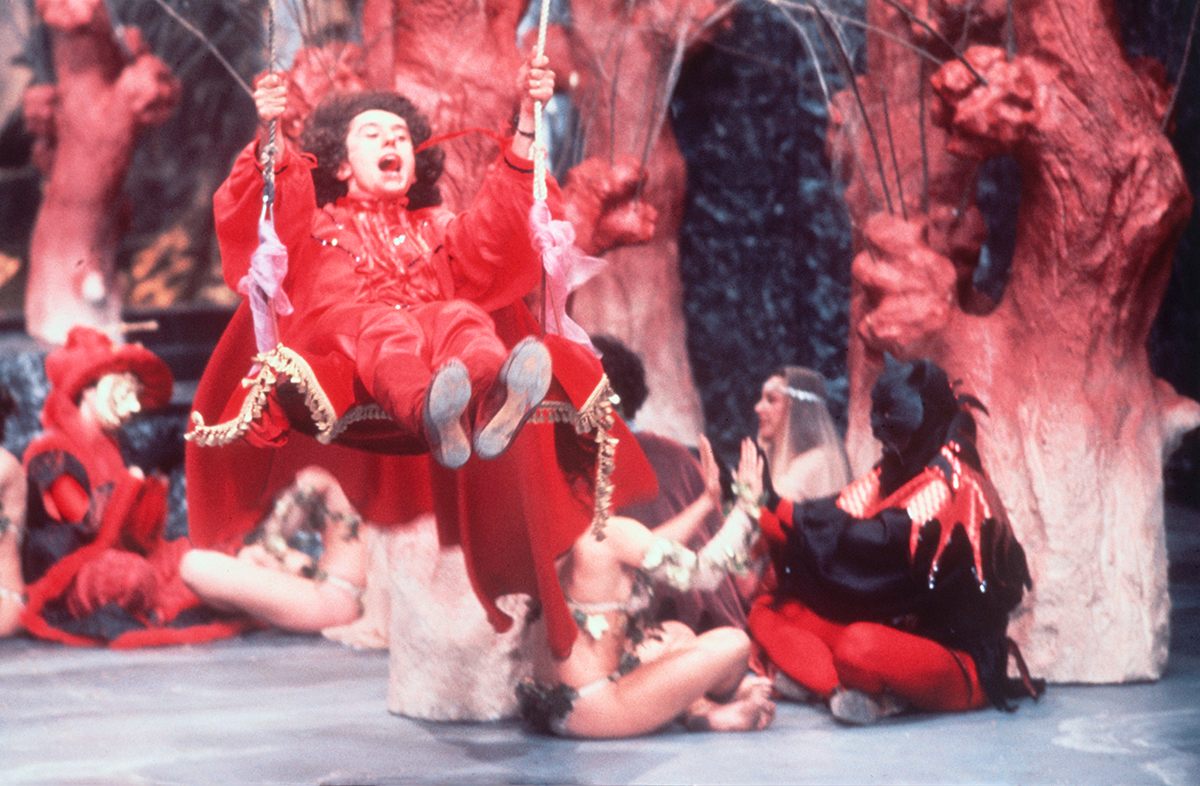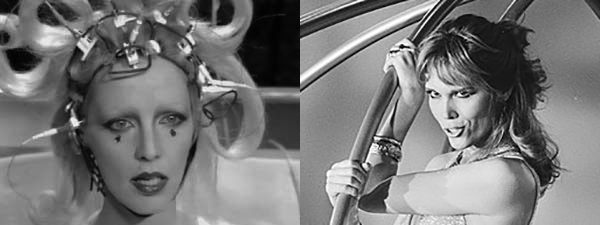For a Brief Time in 1978, Italy Had a Televised Satanic Variety Show
It featured Grace Jones, occult medieval imagery, and the devil himself.

A lithe blonde woman climbs onto a translucent, elevated platform, wearing a crimson sequined unitard and opera gloves. “Give a little ‘mmm’ to me, and I give a little ‘mmh’ to you,” she sings hoarsely, while backup dancers in goblin and sorcerer-like attire stare at her from the sidelines. She then proceeds to cuddle the three black kittens that huddled at the center. The animal is almost limp in her hands. “Are you devil or angel?” she asks, crawling on all fours like a feline. “Are you question or answer?”
What might sound like a show curated by a Brooklyn experimental arts venue is actually a piece of footage from Stryx, a variety show that ran on RAI, Italy’s national television network, in the fall of 1978. The performer was Amanda Lear, the French-born entertainer and gay icon who was a muse to David Bowie and Salvador Dalí in the 1960s, then reinvented herself as a disco queen in Italy, France and Germany in the 1970s.
How did Stryx, a primetime show featuring explicit sexual imagery and sorcery-related symbolism, land on the national television network of a country ruled by the Christian Democracy party?

Enter Enzo Trapani, a TV screenwriter and director who was known as an unpredictable and enigmatic creative, albeit a very successful one. In an interview with Sorrisi e Canzoni, the Italian equivalent of TV Guide, he claimed that he had gotten an odd call in the middle of the night. A man talking in a courteous and measured tone apologized for calling at such an ungodly hour, then complained about the lack of representation “he” had on national TV. He asked why nobody was writing a show about “him.” “You see,” he concluded, feigning embarrassment, “I am the devil.”
It is still unknown whether this was a prank call or whether Trapani made the story up—subsequently, he simply said inspiration struck while he was eating salame with figs and that he just wanted to create a musical variety show that did not necessarily have to be mundanely puritan. “Begone milquetoast rhythms and family-friendly songstresses with round cheeks and heart-shaped mouths,” he elaborated.

One year later he unveiled Stryx, a bacchanalian, neopagan varieté with a dab of satanism. The richly decorated set looked like the lair of the lord of the underworld, and not for the mere sake of the plot. Color TV was finally becoming available in the majority of Italian households, and Trapani decided to use Stryx as a vessel for new technologies: chromakey, distorting lenses, dry ice, and mock-3D special effects were deployed to make Stryx the ultimate visual feast.
At the heraldic cry of “Ladies and Gentlemen, the Devil,” a procession of demons, goblins, odalisques, and dancers would enter the stage. An expert in Neapolitan esoteric lore would explain the fundamentals of palmistry, kabbalah, and tasseography. Performers bared their breasts in an adaptation of the dance of the seven veils, made human sacrifices, and got branded by a Caligula impersonator.
Mostly, though, they sang.
The Stryx[es] were the performers who brought the bacchanalia envisioned by Trapani to new heights. Their musical performances from the show are the few pieces of footage from Stryx that survive online—complete episodes are, unfortunately, unavailable.

The Stryx performer perhaps best known to U.S. audiences was Jamaican-born Grace Jones, a disco queen. She was often clad in skimpy leopard pelts or bikinis, and, beside belting hits such as Fame, she also put her own spin on the classic Italian song “Anima e Core,” which she sang to a disco beat: true to Stryx’s trippy aesthetic, she performed in a crystal bowl, with a waterfall-like shower over her head and an inordinate amount of bubbles being blown in her direction.
The singer with whom Stryx had the most creative freedom and fun was Patty Pravo, an Italian diva who, in the 1970s, bore an uncanny resemblance to David Bowie. For the song “Vola” (Fly), she was strapped to an EEG machine for what looked like shock treatment, during which her space-age makeup remained impeccable. For “Bello” (Beautiful), goblins carried her around on a litter as a naked human sacrifice writhed at the stake in the background.
To heighten the medieval ambience, Italy’s own minstrel, Angelo Branduardi—per Stryxian lore, “musicus diabolicus,” an imp who was captured from a forest—would sing while playing the devil’s instrument, the violin. The majority of his repertoire relied heavily on medieval and renaissance-inspired lyrics and melodies. While his ballad “La Pulce d’Acqua” (The Water Bug) had a set design that was as trippy as any hippy fantasy, it was his “Ballo in Fa Diesis Minore” (Dance in F Sharp Minor) that best conveyed Stryx’s atmosphere, edging between the macabre and the bacchanalian. The song, featured in the video below, is a danse macabre, in which Death introduces herself to a group of people, and is then invited to dance with them.
Medieval-inspired atmospheres and nudity were not completely new to Italian viewers. The 1970s saw a few TV programs that were rooted in the fascination with the Middle Ages. Dirodorlando (a made-up word), for example, was a youth-oriented educational show that aired from 1973 to 1975. It consisted of a series of quizzes, uttered in mock-medieval Italian, that were said to be taken from a fictional incunabulum. Nudity had appeared on TV in 1976 on the program Odeon, which showed the topless dancers of Paris club Crazy Horse. But the combination of these two elements proved to be quite hard to swallow. After the first episode of Stryx aired on October 15, 1978, RAI was inundated with phone calls from outraged viewers: the average Italian TV spectator was not accustomed to an ironic appreciation of the devil and goblins, human sacrifices, and bare breasts. Viewership peaked at nine million, which was not a rating considered satisfactory for a primetime show. For this reason, Stryx was cut after six episodes.
As for Enzo Trapani, his career ebbed and flowed in the following years, even though he never completely abandoned the visionary and lysergic spirit of Stryx. His C’era Due Volte (Twice Upon a Time), the venture that immediately succeeded Stryx, largely consisted of fairy tales retold in absurd ways by porn star Ilona Staller, better known as La Cicciolina. Haunted by paranoid thoughts of aging and of being unable to turn his ideas into TV shows, he would end up dying of a self-inflicted gunshot in 1989. “I made this gesture on my own will, no one else bears any responsibility,” his note read. “He was the first TV director to see my potential,” Verdone reminisced. “He lifted me up in the best possible way, and I still have to thank him.”
A dark turn, yes, but, Trapani himself did embrace darkness in his life. Stryx itself, as full of debauchery as it might have been, had a darker undertone, underlining the outcast-like nature of the characters inhabiting that world. “Performers have always been dear to the devil,” he told TV Sorrisi e Canzoni, “to the point that, up until very recently, they could not be buried on sacred ground.”









Follow us on Twitter to get the latest on the world's hidden wonders.
Like us on Facebook to get the latest on the world's hidden wonders.
Follow us on Twitter Like us on Facebook